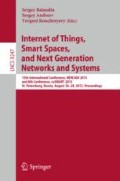Abstract
In the article, a review of the existing methods of transmitted information falsity diagnostics is presented. A conclusion concerning the purposefulness of this function realization in polymodal infocommunication systems has been drawn. A method of defining the multimodal information falsity transmitted in the course of communication act with the help of these systems has been suggested. Common tendencies concerning the dynamics of subscribers’ non-verbal behavior parameters have been formulated. Based on the factor and multiple regressive analysis, the factors depending on such dynamics have been distinguished. Based on the carried out research, a conclusion concerning the possibility of realization of transmitted information falsity in the course of interpersonal communication between subscribers has been drawn and a decisive rule has been formulated.
Access this chapter
Tax calculation will be finalised at checkout
Purchases are for personal use only
Preview
Unable to display preview. Download preview PDF.
References
Basov, O.O., Saitov, I.A.: Basic Channels of Interpersonal Communication and their Projection onto Infocommunicational Systems. SPIIRAS Proceedings 30, 122–140 (2013). (In Russ.)
Vrij, A.: Detecting Lies and Deceit: The Psychology of Lying and the Implications for Professional Practice. Wiley (2000). ISBN: 9780471853169
Gruzyeva, I.V.: Formal-dynamic and Stylistic Peculiarities of Individuality as Factors of Instrumental Detection of the Concealed Information. Author’s Abstract. Cand. Sc. {Psychology} (2006) (in russ.)
Usanov, D.A., Romanova, N.M., Skripal, A.V., Rytik, A.P.,Vagarin, A.J., Samokhina, M.A.: Method of estimation of psychophysical condition of person. Patent RU 2337607, Ap-plication 2007111403/14, 28.03.2007, Bull. 31 (2008)
Morozov, V.P., Morozov, P.V.: Method for estimating sincerity-insincerity of speaking person. Patent RU 2293518, Application 2005124844/14, 04.08.2005, Bull. 5 (2007)
Nierenberg, G.I., Calero, H.H.: How to Read a Person Like a Book. Pocket Books (1990). ISBN: 0671735578
Pease, A., Pease, B.: The Definitive Book of Body Language. Bantam (2006). ISBN: 9780553804720
Vrij, A.: Detecting lies and deceit: pitfalls and opportunities. Wiley (2008). ISBN: 9780470516249
Ekman, P.: Emotions Revealed: Recognizing Faces and Feelings to Improve Communication and Emotional Life. Henry Holt and Co. (2004). ISBN: 080507516X
Butovskaya, M.L.: Body Language: Nature and Culture (Evolutionary and Cross-Cultural Bases of the Human Nonverbal Communication). Scientific World (2004) (in russ.)
Ronzhin, A., Budkov, V.: Speaker turn detection based on multimodal situation analysis. In: Železný, M., Habernal, I., Ronzhin, A. (eds.) SPECOM 2013. LNCS, vol. 8113, pp. 302–309. Springer, Heidelberg (2013)
Ackerl, К., Atzmuller, M., Grammer, К.: The Scent of Fear. Neuroendocrinology Letters 23, 79–84 (2002)
Meshcheryakov, R., Bondarenko, V.: Dialogue as a basis for construction of speech systems. Cybernetics and Systems Analysis 44(2), 175–184 (2008)
Basov, O., Basova, A., Nosov, M.: Human resources management in conditions of operators’ psychophysiological state changes. In: Ronzhin, A., Potapova, R., Delic, V. (eds.) SPECOM 2014. LNCS, vol. 8773, pp. 259–267. Springer, Heidelberg (2014)
Bouguet, J.-Y.: Pyramidal Implementation of the Lucas-Kanade Feature Tracker Description of the algorithm. Intel Corporation Microprocessor Research Labs (2000)
Castrillyn, M., Deniz, O., Hernandez, D., Lorenzo, J.: A Comparison of Face and Facial Feature Detectors based on the Viola-Jones General Object Detection Framework. Machine Vision and Applications 22(3), 481–494 (2011)
Bradsky, G., Kaehler A.: Learning OpenCV. O’Reilly Publisher (2008)
Field, A.: Discovering Statistics using IBM SPSS Statistics. SAGE Publications Ltd. (2013)
Author information
Authors and Affiliations
Corresponding author
Editor information
Editors and Affiliations
Rights and permissions
Copyright information
© 2015 Springer International Publishing Switzerland
About this paper
Cite this paper
Basov, O., Ronzhin, A., Budkov, V., Saitov, I. (2015). Method of Defining Multimodal Information Falsity for Smart Telecommunication Systems. In: Balandin, S., Andreev, S., Koucheryavy, Y. (eds) Internet of Things, Smart Spaces, and Next Generation Networks and Systems. ruSMART NEW2AN 2015 2015. Lecture Notes in Computer Science(), vol 9247. Springer, Cham. https://doi.org/10.1007/978-3-319-23126-6_15
Download citation
DOI: https://doi.org/10.1007/978-3-319-23126-6_15
Published:
Publisher Name: Springer, Cham
Print ISBN: 978-3-319-23125-9
Online ISBN: 978-3-319-23126-6
eBook Packages: Computer ScienceComputer Science (R0)

